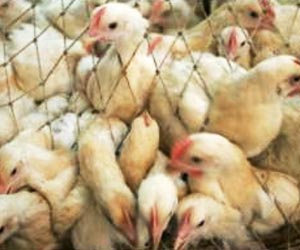Even though India have contained the spread of the bird flu successfully, scientists testing for the H5N1 virus are still worried about the presence of a live chain of the disease.
Researchers at the High Security Animal Disease Laboratory here say that many of the samples are unfit for testing as proper procedures were not followed for their collection and preservation."Most bird flu samples reaching us remain unfit for testing," H.K. Pradhan, head laboratory, told IANS. Several thousand samples, packed in iceboxes, arrive in the lab from various places.
"Many of the samples come in such a poor condition that it is not possible for the virus to be alive," he lamented.
The four samples that tested positive last week, he said, were from scattered domesticated population. "Though the samples showed the presence of the H5 virus, their N1 status could not been tested.
"But it is quite certain that they would have tested positive for N1 as well which means the virus is still in the environment and a direct link exists, as H5N1 cannot transmit without a live carrier," Pradhan said.
Culling and cordoning of affected zones - predominantly in Maharashtra - were done quickly enough to check the spread of the disease, he said. But the existence of a live bird chain is worrying.
Advertisement
"It is not possible to get a clear picture of the spread of the disease because proper procedures while collecting and preserving samples for testing are not followed.
Advertisement
Narrating the example of a sample that was so bad that scientists had to dump it in the incinerator without even opening it, Pradhan said: "A sample has to reach us when the virus is alive in the medium - dead chicken, blood, egg, tissue, or faecal matter - by maintaining a cold chain and sticking to the time of collection and packaging norms".
As for the culling procedure, Pradhan said, it is better to burn the carcasses.
"Buried animals can be dug out by dogs or jackals if the hole is not deep enough or they have not been treated properly with lime and chemicals," he said.
The lab is at present running out of time and space. While it can handle a maximum of about 2,000 blood samples and 100 tissue and faecal samples a week, it has been receiving 4,000 samples every week over the past month.
Six out of the eight rooms in the laboratory are now engaged in H5N1 work, distributed across a dozen scientists.
The pressure is forcing Pradhan and his colleagues to pick and choose samples.
"There is pressure," Pradhan admits, adding: "The top priority is for samples from sites with mortality."
--Edited IANS




